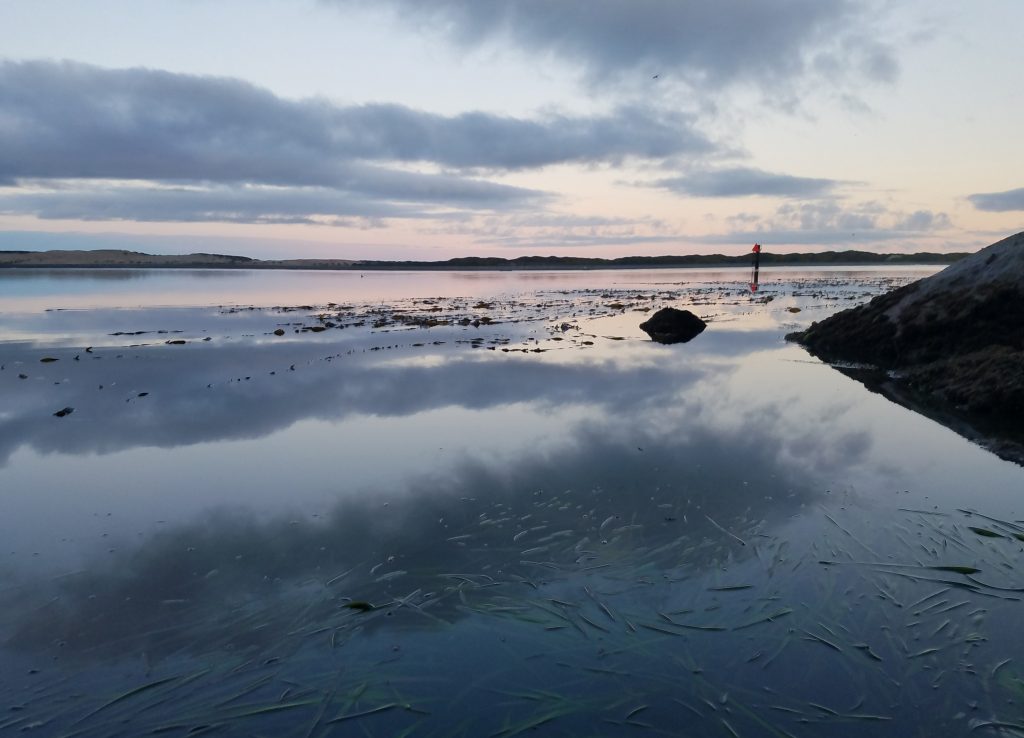In today’s post, Blake Toney, former Morro Bay National Estuary Program Field Tech, reflects on an early morning spent monitoring eelgrass during a very low tide in Morro Bay.
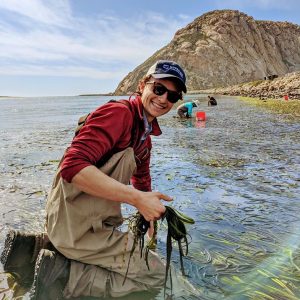
5:40 a.m.
I arrive at today’s site a few minutes before my coworkers to get my bearings. The sun will not rise for another hour, but already the dark sky has begun to take on a hint of blue so faint it becomes harder to see when I concentrate on it. The moon provides some light, enough for me to trek out across the mud after struggling to fit into my waders between gulps of now lukewarm coffee. I should have made more coffee, I think to myself.
5:50 a.m.
With boots on and mug in hand, I begin to creep out along the mudflat, stepping gingerly so as to avoid sinking into soft spots. I’ve seen this beach many a time from the perspective of a kayak, but seldom visited on foot. When I first came to Morro Bay, I named all of the places that I loved to help feel acquainted with the place, to develop my own mental map of the hidden gems this bay holds. I stroll out along Cypress Avenue Beach, or so I had christened it on account of the wind-swept trees that line the road and the Van Morrison song. The true name of this beach, Windy Cove, certainly holds meaning as well, as any springtime afternoon paddle-boarder or kayaker will tell you.
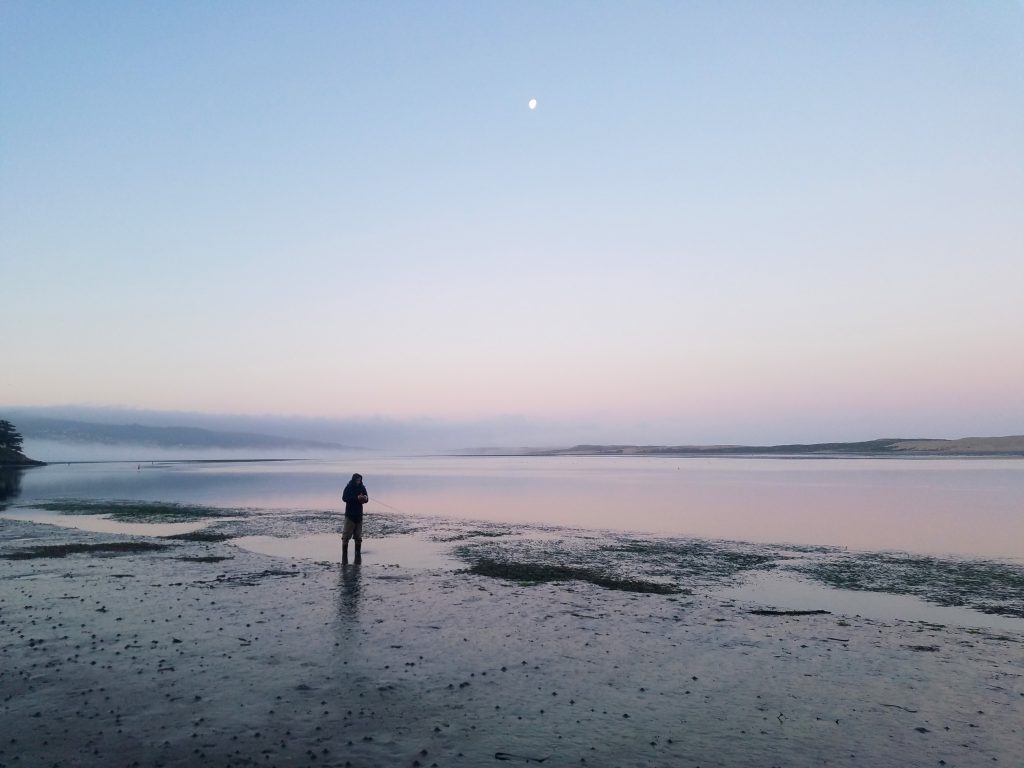
5:55 a.m.
As I near the Heron Rookery, the realization that I am not alone slowly brings itself to the front of my consciousness. A deep, gravely croak fills the still morning air. It sounds as though the eucalyptus trees are filled with some exotic mammal that belongs deep in a hidden rainforest, and yet, the creator of this call is not a mammal nor stranger at all. I can begin to make out the shadows of double-crested cormorants nesting throughout the trees above the small bluff. I avoid getting too close so as not to disturb their morning routine. If they’re anything like me, these next few minutes require all the will power they can muster, and based on the labored nature of their calls, I find no difficulty in seeing a likeness between them and myself.
I see a pair of headlights pull into the gravel parking lot, and leave the birds to pull themselves from the comfort of their shelter. I should have made more coffee, I think to myself.
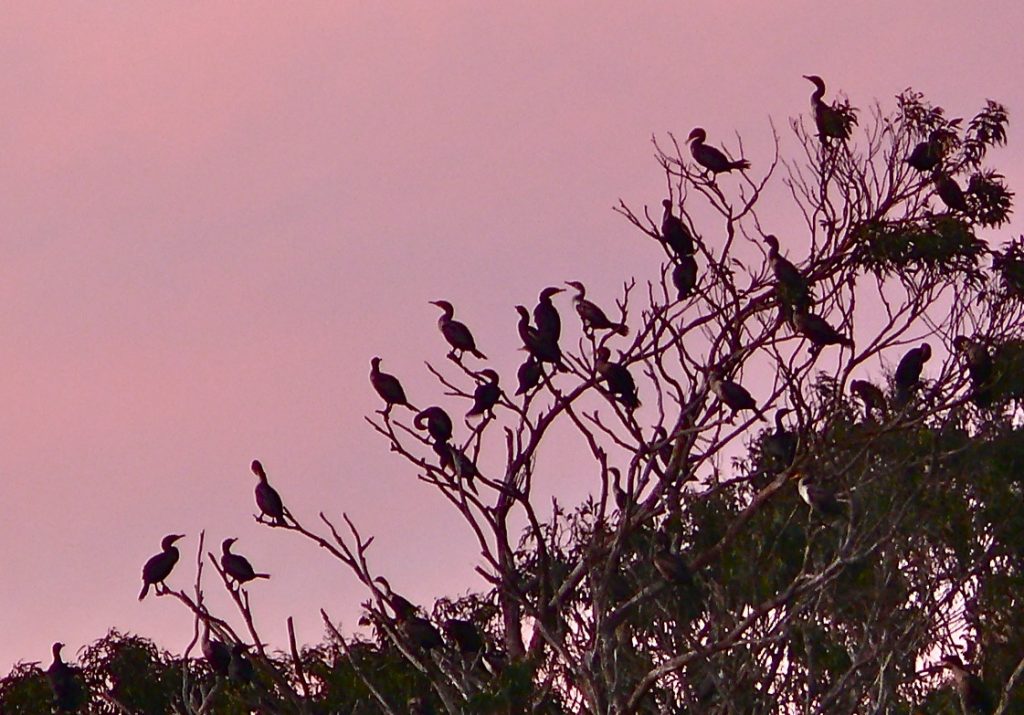
6:10 a.m.
We begin to unpack gear from our cars and identify the plan. Today we are here to complete eelgrass bed-condition monitoring. That essentially translates to assessing the health of existing eelgrass beds from Coleman Beach in the north to as far south as the State Park Marina. In order to do this, we deploy staff into the field at extreme low tides to perform a series of quantitative and qualitative measurements of things like stipe density, blade length, the presence or absence of epiphytes (algae that grows on eelgrass), and other components of eelgrass health. We also measure the length and patchiness of the bed, so as to create an image of bed growth or decline over time.
6:35 a.m.
I am well into completing my first quadrat for the day, having counted eighteen eelgrass stipes in Section One, thirty-two stipes in Section Two, twenty-four in Section Three, and twenty-eight in Section Four. I begin to have a growing sense of respect for agricultural workers that spend entire days hunched over the earth harvesting crops, while I find myself sore and uncomfortable after less than an hour. I see a small hermit crab scurry from one place of apparent security to another and forget about my own.
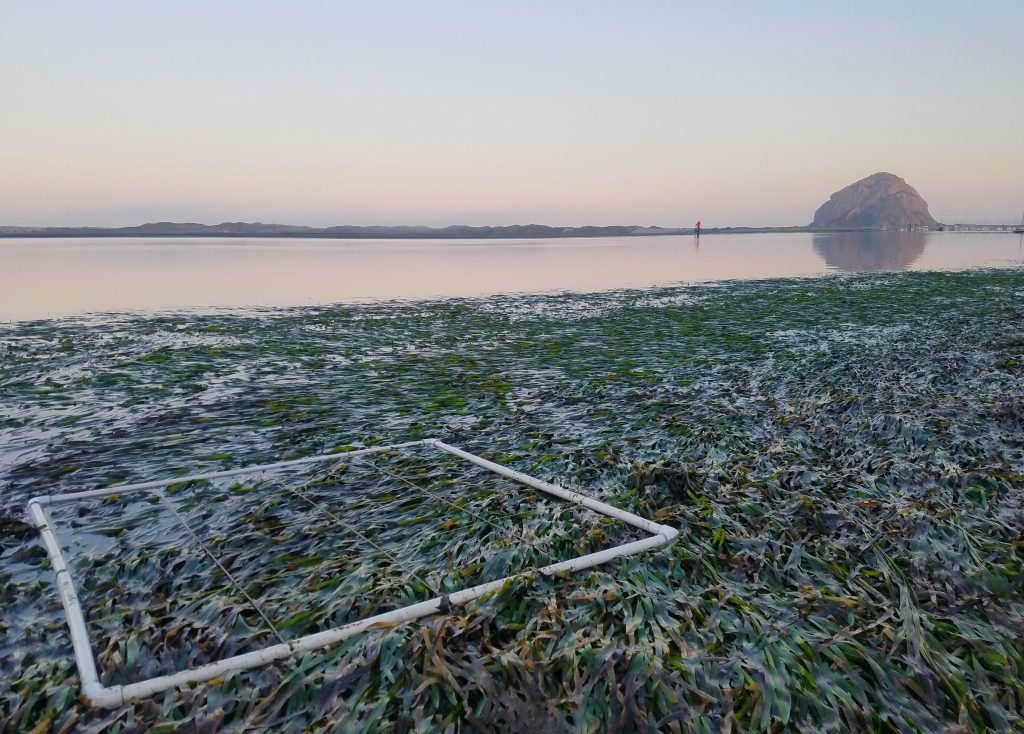
7:15 a.m.
I race to finish completing my last quadrat of the day as I feel the tide slowly creeping up behind me as if it were a predator and I its prey. These surveys can only be completed at significant low tides that expose eelgrass beds, allowing us a short window of time to do our work before being chased back to the beach above the mudflats.
An invitation
The low tide exposes a world less visited by the likes of you and me, and holds treasures seldom seen. So, if ever the world seems to have lost its luster or sense of mystery, I urge you to explore the tide pools and mudflats at sunrise on a low tide. To hear the croak of the waking cormorant and the squelching of mud below your feet, and to be reminded of the beauty in our own backyard.
“There is in our community an elderly painter of seascapes who knows the sea so well that he no longer goes to look at it when he paints. He dislikes intensely the work of a younger painter who sets his easel on the beach and paints things his elder does not remember having seen”
– John Steinbeck, forward to Between Pacific Tides, 1948 edition
Subscribe to our weekly blog to have posts like this delivered to your inbox each week.
Help us protect and restore the Morro Bay estuary!
- Donate to the Estuary Program today and support our work in the field, the lab, and beyond.
The Estuary Program is a 501(c)3 nonprofit. We depend on funding from grants and generous donors to continue our work. - Support us by purchasing estuary-themed gear from ESTERO. This locally owned and operated company donates 20% of proceeds from its Estuary clothing line and 100% of Estuary decal proceeds to the Estuary Program. Thank you, ESTERO! In addition to purchasing ESTERO gear online, you can buy it at Joe’s Surf Shop in Morro Bay and support two local businesses at once.
- Purchase items from the the Estuary Program’s store on Zazzle. Zazzle prints and ships your items, and the Estuary Program receives 10% of the proceeds. Choose from mugs, hats, t-shirts, and even fanny packs (they’re back!) with our fun Estuary Octopus design, our classic Estuary Program logo, or our Mutts for the Bay logo.
